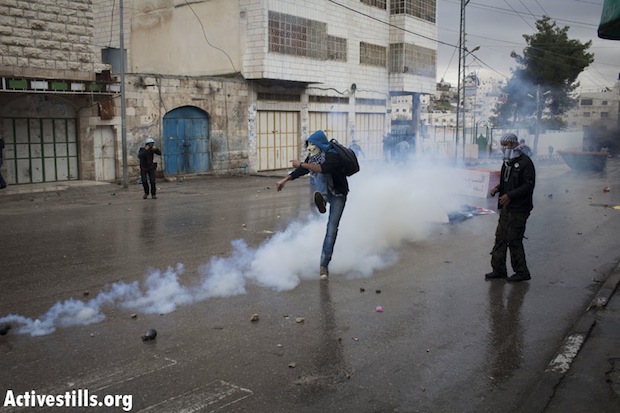Army used tear gas, skunk and an American-made sound device against protesters. Dozens were injured, and at least two Palestinians and one Israeli were arrested.
By Max Schindler
Hundreds of Palestinians, Israelis and internationals descended upon Hebron on Friday to protest the 18-year closure of a main thoroughfare, Shuhada Street.
Approximately 500 demonstrators—many hoisting Palestinian flags and chanting anti-occupation slogans— converged a few hundred meters from the closed street. As they attempted to approach Shuhada Street, Border Police forces dispersed the rally by throwing stun grenades, shooting tear gas, and spraying “skunk” liquid.
Palestinian teenagers threw stones at the soldiers. Several Molotov cocktails were thrown at army vehicles.
Amid wafts of tear gas that led to crying and coughing fits, ambulances careened with sirens wailing. Demonstrators huddled in alleyways breathing through keffiyehs soaked in lemon juice.
[youtube]http://www.youtube.com/watch?v=geTiWN4JG08[/youtube]
Access to the commercial street—formerly housing the Hebron vegetable market— was restricted following a massacre committed by a local settler at the Cave of Patriarchs, a holy site to Muslims and Jews. Baruch Goldstein, a doctor from the nearby Kiryat Arba, shot and killed 29 praying Palestinians; another 125 men were injured. In the years that followed, further restrictions were imposed on movement of Palestinians within certain areas in Hebron.
Around 160,000 Palestinians reside in Hebron, according to a 2007 Palestinian Central Bureau of Statistics report. Several hundreds settlers live among them, in the eastern part of the city, under heavy military guard. Jewish settlers are permitted to use Shuhada Street while their Palestinian counterparts cannot walk on the once busy access road.
“The Israeli authorities have created a system of separation where Palestinians are not allowed to drive or walk in the neighborhood,” said Hisham Sharabat, an activist for al-Haq human rights organization, adding that Israeli officials use the pretext of security to justify the street closure.
Sharabat noted that 520 shops in the area were shut down by the Israeli military over the years.
At Friday’s protest, three demonstrators were arrested — one Israeli and two Palestinians— said Sami Natsheh, an organizer for Hebron Defense Committee. Dozens of protesters were treated for injuries resulting from tear gas and skunk liquid according to Mahmoud Sinnokoret, an EMT from Palestinian Medical Relief. Sinnokeret helped rush the injured to the two local hospitals in Hebron. “Most cases of injuries were asphyxiation with poison gas and burns,” he said.
Israeli-Palestinian Knesset member Mohammed Barakeh of the Jewish-Arab Hadash party was pushed by the soldiers. “They [the soldiers] shot a sound bomb right at his right leg,” Natsheh said. Here is a video of Palestinian youth activist Fadi Quran attacked by the soldiers for shouting at them:
[youtube]http://www.youtube.com/watch?v=fUeJEUX5Vtc[/youtube]
Nearly 200 Israelis participated in the march, an unprecedented number that reflects growing interest in the cause, said Matan Boord, an activist with Tarabut-Hithabrut, an Israeli joint-action group that was involved in the protest. Protesting together poses challenges, Boord noted. “After 20 years of [peace] talks for nothing, Palestinians are very suspicious. What we are trying to do is build a political and ideological basis for a joint struggle.”
The protest was organized by Youth Against Settlements, with a second demonstration in the city organized by left-wing Palestinian parties— People’s Party, Popular Democratic Front, and the National Initiative, Mustafa Barghouti’s party— along with counterpart Israeli organizations opposing the occupation. Fatah did not participate officially.
Yehoshua Rosen, an Israeli who escaped Nazi Germany in 1937, came to take part in the protest. “I believe in a Palestinian state next to Israel,” Rosen said. “[Yitzhak] Rabin spoke of peace but no other government since has done something.”
At one point, Israeli soldiers used new noise technology to break up the rally. As they ratcheted up the crowd control techniques, a loudspeaker blared: “This is the test of long-range device LRAD from American technology corporation.”
[youtube]http://www.youtube.com/watch?v=fthlrnS-C_0[/youtube]
Despite the seeming inability of the demonstrators to reach Shuhada Street, organizer Badran Gaber focused on the fight ahead. “Our struggle will continue with all of you, against the occupation.”
Read Also:

